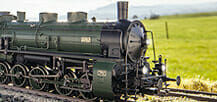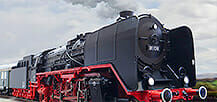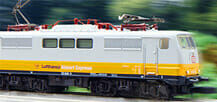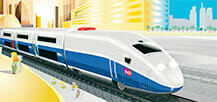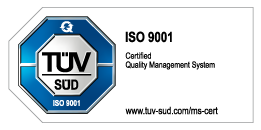Electric Locomotive.
Prototype: German Federal Railroad (DB) class 120.0 express general-purpose locomotive. Original version.
Most Important Facts
| Article No. | 37537 |
|---|---|
| Gauge / Design type | H0 / 1:87 |
| Era | IV |
| Kind | Electric Locomotives |
Check with your local dealer Find Dealer
Highlights
- New metal body.
- Engineer"s cabs have interior details and lighting.
- All of the lights are maintenancefree LED"s.
- Digital sound: Locomotive whistle.
-
Product description
Model: Locomotive comes a Locomotive comes with a digital decoder, controlled high-efficiency propulsion, sound and lighting effects. 2 axles powered. 4 traction tires. Headlights are maintenancefree LED's. Headlights will work in conventional operation and can be controlled digitally. Engineer's cab lighting, sound effect of a whistle as well as the acceleration and braking delay can be controlled digitally with the 6021 Control Unit. Engineer's cabs have interior details. Separately applied grab irons. Length over the buffers 22.1 cm / 8-11/16".
Find more Märklin explanation videos on our YouTube Channel
Spare parts for our articles can be found here in our spare parts search.
-
Publications
- New items brochure 2004 - Product programme 2005
-
Prototype information
The Three-Phase Current Pioneer. The class 120 marked the technological change to three-phase current propulsion. This principle promised compact, motors without commutators and largely free of parts that would wear out, commutator rings, brushes, and mechanical contacts. Because a wide torque range and rpm range can be mastered with three-phase current technology, the performance specifications for this new development were broadly formulated. The class 120 was designed to pull 200 km/h or 125 mph fast InterCity trains and 5,400 metric ton freight trains and be equipped with push/pull controls and electric regenerative brakes. In 1977, the DB ordered five experimental units, which were thoroughly tested on test stands, on test runs, and in operational use. Startup, tractive effort, acceleration, running characteristics, braking power, power consumption, and stability were on the program. Comparison tests with other makes of locomotives as well as startup tests on the Lötschberg and Semmering grades confirmed the effectiveness of the technology. The speed record was 265 km/h or 165 mph. During the test phase, new developments were introduced, for example: microprocessors for faster monitoring and control. Components were constantly improved until all five units were technically at the same level in 1982 and were ready for regular production. During the several years of development the purchasing policy changed, however. Instead of all-round locomotives, special locomotives were once again preferred on the basis of common development platforms with many parts in common. Therefore, only the first production run of 60 units were purchased of the class 120. The five prototypes, to which the prototype of our model also belongs, continue to be used for test purposes.
